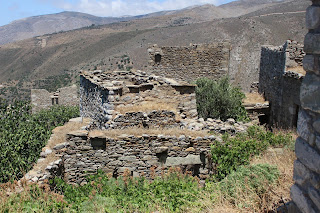On Sunday, June 10th, we all got on the bus and
headed south toward the Mani Peninsula, Danae’s ancestral homeland. First stop was at an olive mill—much more of
a non-commercial, artisan producer than the one we had visited in Crete. We viewed the press and saw a video. The shop was, if anything, more interesting.
Afterwards, we went across the road to a tavern, where Danae
demonstrated how the Greeks make coffee.
When we had drunk ours, we tried to see our fortunes in the grounds. I saw a volcano in mine—Hawaii? Mary Joy had what looked like a loon, the
Minnesota state bird.
Then we continued driving along the dry, bare coast, with terrain
looking much like one of the Aegean islands.
The Mani was known for being a hard land, with hard people. Insult one of them and you were likely to
have a multi-generation family vendetta on your hands. Now, nearly everyone has escaped, from the
poverty and the violence. We stopped and
wandered around Vathia, a ghost town that the government had tried, unsuccessfully,
to turn into a resort.
Near the very tip of the Mani, close to Cape Tenaro, the
southernmost point in mainland Europe, is Marmari, where an Orthodox priest had
created a restaurant and beach resort.
We had a pleasant lunch there, then headed back north to Glythio, then
to Monemvasia.
We checked into our room at the Hotel Panorama, which had a
balcony overlooking the Rock: the island, like a mini-Gibraltar, that served as
a fortress during medieval and early modern times. No one ever took it by storm, but several
times it was besieged and starved out.
We walked down to the waterfront, where we heard part of a concert by a
children’s choir. Then we joined some of
the others in our group for dinner, during intermittent drizzle, at the
waterfront Taverna Skorpios. Our
souvlaki wasn’t great.



































No comments:
Post a Comment